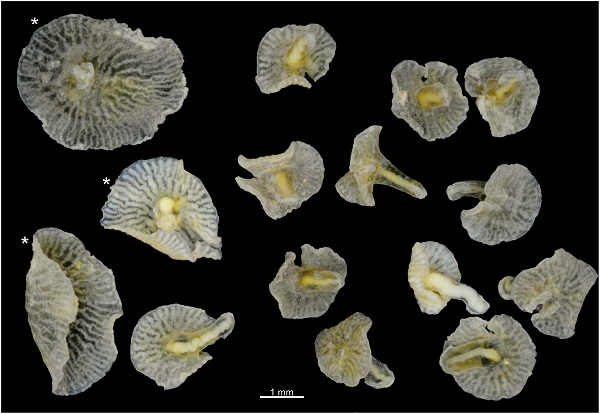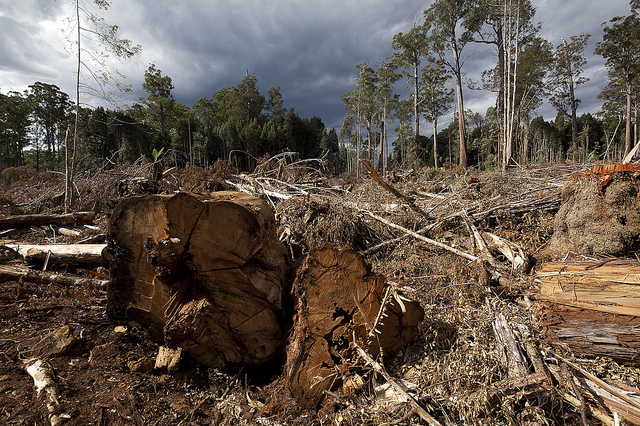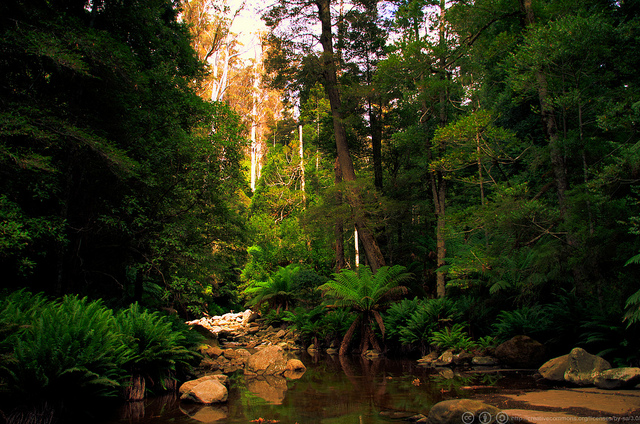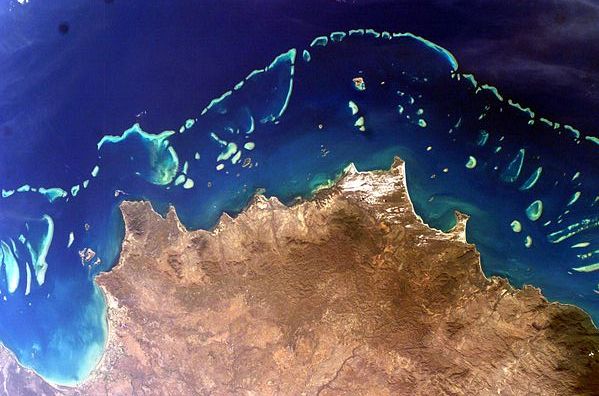Search Results for Tag: Australia
Dendrogramma, a #speciesoftheweek that could rewrite the tree of animal evolution

Dendrogramma by Jorgen Olesen, Figure 1. Dendrogramma gen. nov., doi:10.1371/journal.pone.0102976.g001
Almost 30 years ago, Biologist Jean Just and his colleagues took samples from the deep sea close to Australia. They used some kind of a wire-mesh cage, dragged by a rope on a ship, to skim the top layer of soil from the ocean floor at 400 and 1000 meter depth. These cages dug out and carried away everything that could not escape fast enough. Among the findings were mushroom-shaped organisms. And in 1986 the scientists had no clue what they had brought to their lab.
So the just a few millimeter sized creatures went the way of all still to be classified findings – and there had been a lot in the cages – it was conserved in the best possible way, in alcohol. Unfortunately, this conservation method is not approriate for any moleculobiological analysis after such a long time, to determine the species’ origin. But it was obvious to the researchers, that even though the organisms shares some of it’s features with comb jellies and Cnidaria it does not belong to either one of them. The species, they named Dendrogramma during the process, does neither feature stinging cells or tentacles (as Cnidaria) nor the typical sensory organs of comb jellies.
Now they know that they had discovered something very special, a new genus: Dendrogramma. And on top of that with two new species named Dendrogramma enigmatica and Dendrogramma discoides.
What does this discovery mean for the family tree of the animal species?
Having found animals that can not be classified to any existing animal group could help to get a clearer view on the evolution of animal kingdom at all. The National Geographic quotes Leonid Moroz, a neurobiologist at the University of Florida: If the new species turn out to be descendants of early animals, the find could “completely reshape the tree of life, and even our understanding of how animals evolved, how neurosystems evolved, how different tissues evolved.” An he adds: “It can rewrite whole textbooks in zoology.”
The research has only just begun.
For what we risk biodiversity (2): Toilet paper
Author: Kerstin Schnatz
The tallest hardwood trees on earth are towering 90 meters and more in height in Tasmania. The island state 240 km South of the Australian mainland is not just famous with hikers and nature lovers – it also has a very strong timber industry. Now the Australian government wants to open more forest sites for potential logging.

Picture from February 2012: A logging site close to the Tasmanian Wilderness World Heritage Area.
(Photo credit: CC BY NC SA 2.0: Ta Ann Truths)
Almost 50% of Tasmania’s land area is protected for a good reason: The ancient forests give a habitat to many threatened species such as the almost extinct Tasmanian devil or the endangered Tasmanian wedge-tailed eagle.
Now the worst nightmare of Australian environmental activists has come true: Their government has put in a pledge to the United Nations to remove 74.000 hectares of Tasmanian forest from world heritage listing. The very land had only been protected in 2012 within a larger area of 174,000 hectares, ending a decades long conflict between the timber industry and environmental groups. The reason? The relativele new Australian government that had been elected in 2013 finds the area not so special after all. Government speakers reckon that much of the area had been logged already anyway and should not have been considered for protection in the first place.
Naturally, environmental groups think of this otherwise stating that almost 93% of the area in question consists of precious old growth forests. They fear, that their government wants to open the doors for the Tasmanian timber industry – one of the most thriving branches of the tiny state’s economy.
Large international companies such as Malaysian owned veneer manufacturer Ta Ann have wood manufacturing mills in Tasmania. Many of those mills produce woodchips used for making writing paper, tissues or even toilet paper.
To proof how precious and needy of protection Tasmania’s forest are, the Wilderness Society released pictures of the area in question.
Harsher images paints the Tasmanian Leader of the Green party with his words stating in a television report by the national TV channel ABC : “Logging in a world heritage area is akin to the Taliban dynamiting millenia old religious statues.”
We all agree, that nature’s richness is precious and needs to be protected. But at the same time it sometimes “just happens” that this precious biodiversity is set at risk. To raise awareness for this contradiction, we started this little blog series, featuring examples of this phenomenon. See part 1 here. If you know similar examples, that fit into this series, please drop us a line in the comment box below.
For what we risk biodiversity (1): Australia’s coal industry
We all agree, that nature’s richness is precious and needs to be protected. But at the same time it sometimes “just happens” that this precious biodiversity is set at risk. To raise awareness for this contradiction, we start a little blog series, featuring examples of this phenomenon. Here’s our first part:
We risk biodiversity for the coal industry in Australia
The world’s largest variety of corals (more than 350 different species), more than 1500 tropical fish and at least 200 bird species, 20 different types of reptiles like sea turtles, as well as sponges, mollusks, rays and dolphins: the Australian Great Barrier Reef is teeming with life, in an extraordinary variety of colors and shapes.
Despite this richness, the Australian government recently approved four big industrial projects close to the reef, one of them the expansion of a coal port – which means three million cubic meters of seabed have to be removed. The Australian Brisbane Times vizualizes the amount of soil like this: “the amount of dredge to be dumped offshore is enough to fill 150,000 dump trucks lined up ‘‘bumper to bumper’’ from Brisbane to Melbourne.” Though strict guidelines are said to be applied, environmentalists fear, the Great Barrier Reef World Heritage Area will be affected. Greenpeace warns, instead of less then 2000 ships in 2011, more than 10,000 ships would be traveling through the World Heritage site by 2020. What’s more, the massive projected rise in ship traffic, will also increase CO2-emissions and thus accelerate global warming – which in turn further threatens the reef’s corals.
[story found on Grist.org]
Do you also know of more examples? Drop us a line in the comment box below!
“The only living thing that can be seen from the moon”

Don Henry, Australian Conservation Foundation
Interview: Kerstin Schnatz
The Australian Conservation Foundation (ACF) is Australia’s main environment group. With the United Nation’s Earth Summit starting this Wednesday, Global Ideas reporter Kerstin Schnatz spoke to ACF’s executive director Don Henry in Rio de Janeiro. The conference is also known as Rio+20 as it marks the anniversary of the first Earth Summit twenty years ago. Over one hundred world leaders are in Rio to seek answers to global challenges such as climate change or marine pollution.
Global Ideas: If there was one thing you were free to write into the Rio+20 final paper what would it be?
Don Henry: I think there is a very straightforward issue at the moment and that is cutting subsidies for fossil fuels around the world. In Australia, we have subsidies worth billions of dollars that go into making fossil fuels cheaper for the mining industry.
But I would love to also ensure there is much stronger investment into renewable energy and energy efficiency around the world. I’d really like to see the international financial institutions like the World Bank and the International Monetary Fund (IMF) cut any loan programms to the fossil fuel sector and really boost loan portfolios to renewables and efficiency.

Activists at the Rio+20 summit protesting against fossil fuel subsidies
What impacts of climate change do you feel in Australia?
In recent years, we have had some terrible bushfires that have killed a lot of people in extreme, hot weather that has never been seen before in Australia. If the world doesn’t act, our best scientists are saying we are going to get double the amount of droughts and they will be twice as severe over the next 20-30 years. That will also have a big impact on food production in Australia.
And another example, something that is dear to my heart: We are very privileged in Australia that we are the custodians of the Great Barrier Reef, the largest reef system on earth and the only living thing on the planet that can be seen from the moon. The Great Barrier Reef is at grave risk from climate change. The best science out there is saying if global average warming goes beyond two degrees, we will see a severe impact on the reef. It would be a tragedy if our generation allowed one of the great global treasures, the Great Barrier Reef, not to be handed on in good condition to our children.
What is the most important goal Australians have achieved in the last twelve months to tackle climate change?
We’ve had a very big effort from Australian civil society to put a price on carbon emissions. Our government last November passed legislation for a carbon trade scheme. The legislation is complemented by a ten-billion dollar investment into clean energy and a carbon farming initiative that rewards farmers for tree planting and for holding on to forest areas. That’s been an important step forward for us as a nation.
At a side event at Rio+20, nuclear power was promoted as a sustainable way of producing energy. What’s the perception of nuclear power in Australia?
When you look at whether nuclear power is a solution for climate change in Australia, most Australians would say the risk associated with accidents and long lived nuclear waste is not a solution to action on climate change.
Apart from that, Australia is lucky because we receive twice the amount of solar energy per square meter than Germany does. So we have huge potential for renewable energies. We also have extensive gas reserves – which is still a problem with emissions, but gas plants still have less emissions than coal. So I think most Australians feel we don’t have to go there and we shouldn’t.
Australia may not have any commercial nuclear power plants. But the country has a strong mining industry exporting uranium for nuclear power plants around the world.
ACF strongly opposes uranium mining. Because often the mines have been imposed on Aboriginal people, on Aboriginal land without their full consent.
There are also real problems with safety for workers at the mines. For instance one of the mines in the Northern Territory, the Ranger uranium mine, has got a legacy of hundreds of accidents that have affected workers’ health.

Indiginous land owner Yvonne Margarula in front of the Ranger uranium mine. The mining site is surrounded by world heritage listed Kakadu National Park.
And then there is another huge problem: What do you do with the radioactive waste from the mining process itself? For example, a condition of mining operations is they have to make safe the waste ponds for ten thousand years. Human beings are not good at making things safe for one hundred years, much less ten thousand years.
And of course many Australians are very worried with what happens with uranium from Australia overseas. We do know for example, it was Australian uranium in the Fukushima reactors. So in an indirect way, Australia has contributed to the problems associated with the accidents.
What are you expecting to come out of Rio+20?
We are very worried that it will be quite a modest outcome at a time when environmental degradation and sustainability issues are so urgent and pressing globally.
Pictures: Global Ideas/ Dominic O’Brien
Kill a camel, cut pollution
Some Australians came up with a weird idea: Their country could award carbon credits for killing feral camels as a way to tackle climate change. Honestly! The suggestion is included in Canberra’s “Carbon Farming Initiative”, a consultation paper by the Department of Climate Change and Energy Efficiency.
Northwest Carbon, a commercial company, proposed culling some 1.2 million wild camels that live the Outback. The animals are considered a pest due to the damage they do to vegetation. Plus: One camel produces, on average, a methane equivalent to one tonne of carbon dioxide a year, that makes them (all together) one of Australia’s major emitters of greenhouse gases.
The idea is among some other that had been accepted for discussion by the government, which is seeking to “provide new economic opportunities for farmers, forest growers and landholders” if they come up with ways to cut emissions. Legislation for the “Carbon Farming Initiative” is set to go before parliament next week. What the …?!











Feedback